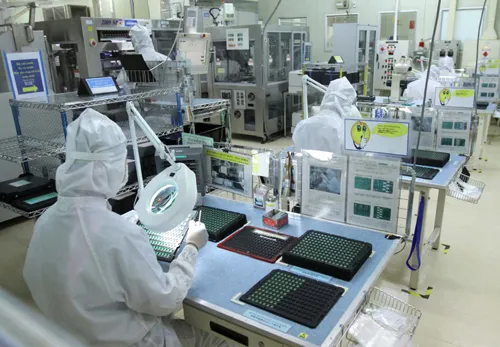Việt Nam's industrial production rises 9.4 per cent in five months


HÀ NỘI – Việt Nam’s industrial production index (IIP) rose 9.4 per cent in the first five months of 2019, driven by growth in the processing and manufacturing industry, power production and distribution, and water supply and waste treatment, data from the General Statistics Office (GSO) showed.
The five-month figure was lower than the 10.3 per cent increase in the same period last year but higher than the growth of 6.6 per cent in 2017 and 7.4 per cent in 2016.
The IIP in May was estimated to rise by 4.6 per cent over the previous month and by 10 per cent over the same period last year, the data said.
The processing and manufacturing continued to play a key role in driving growth across the whole industry with five-month growth of 10.9 per cent, contributing 8.4 percentage points to the overall increase. Notably, the manufacturing of electronic products, computers and optical products started to recover in May after two consecutive months of negative growth.
This industry also attracted the largest amount of foreign direct investment (FDI), with total capital in new projects exceeding US$4.7 billion, accounting for 73.5 per cent of accumulated investment in new projects overall. Additional and new capital injected into the sector reached more than $7 billion, accounting for 77.2 per cent of the total.
Electricity production and distribution ranked second with a five-month increase of 10.3 per cent, followed by water supply and waste treatment with growth of 7.9 per cent.
Some major industrial products also increased substantially compared to the same period last year, such as refined petroleum products (up 74.7 per cent), iron and crude steel (up 66.2 per cent), televisions (up 34.2 per cent), liquefied petroleum gas (LPG, up 26.2 per cent) and automobile (up 17.1 per cent).
On the dark side, oil and gas exploitation and the mining industry dropped 7.9 per cent and 0.1 per cent, respectively.
Some products suffered strong declines such as telephone parts (down 17.9 per cent) and refined sugar (down 13 per cent).
Across regions, 59/63 provinces and cities directly under the central government saw the industrial production index increase compared to the same period of last year, of which Thanh Hóa continued to lead with a 44.8 per cent jump thanks to the Nghi Sơn Refinery and Petrochemicals plant that went into production in mid-2018.
Experts said the country’s industrial growth was driven by increases in the number of enterprises, investment capital and labourers. However, productivity remained low and gaps with other countries like China, Malaysia, Indonesia, the Philippines, India, Thailand, Japan and the Republic of Korea had continued to widen.Industrial growth, especially the processing and manufacturing sector, still relied on FDI firms. Experts suggested creating national brands and competitive products, integrating more deeply into global value chains and stepping up industrial structural reform. — LV
Tags:





